Levett-Jones Clinical Reasoning Cycle: Case Study Analysis
VerifiedAdded on 2023/01/17
|8
|3125
|78
AI Summary
This paper discusses the case study analysis of Peter Mitchell using the Levett-Jones Clinical Reasoning Cycle. It explores the healthcare complications he faces and provides interventions for his priorities.
Contribute Materials
Your contribution can guide someone’s learning journey. Share your
documents today.

Running head: CASE STUDY ANALYSIS
LEVETT-JONES CLINICAL REASONING CYCLE (PETER MITCHELL)
Name of the student
Name of the university
Author note
LEVETT-JONES CLINICAL REASONING CYCLE (PETER MITCHELL)
Name of the student
Name of the university
Author note
Secure Best Marks with AI Grader
Need help grading? Try our AI Grader for instant feedback on your assignments.
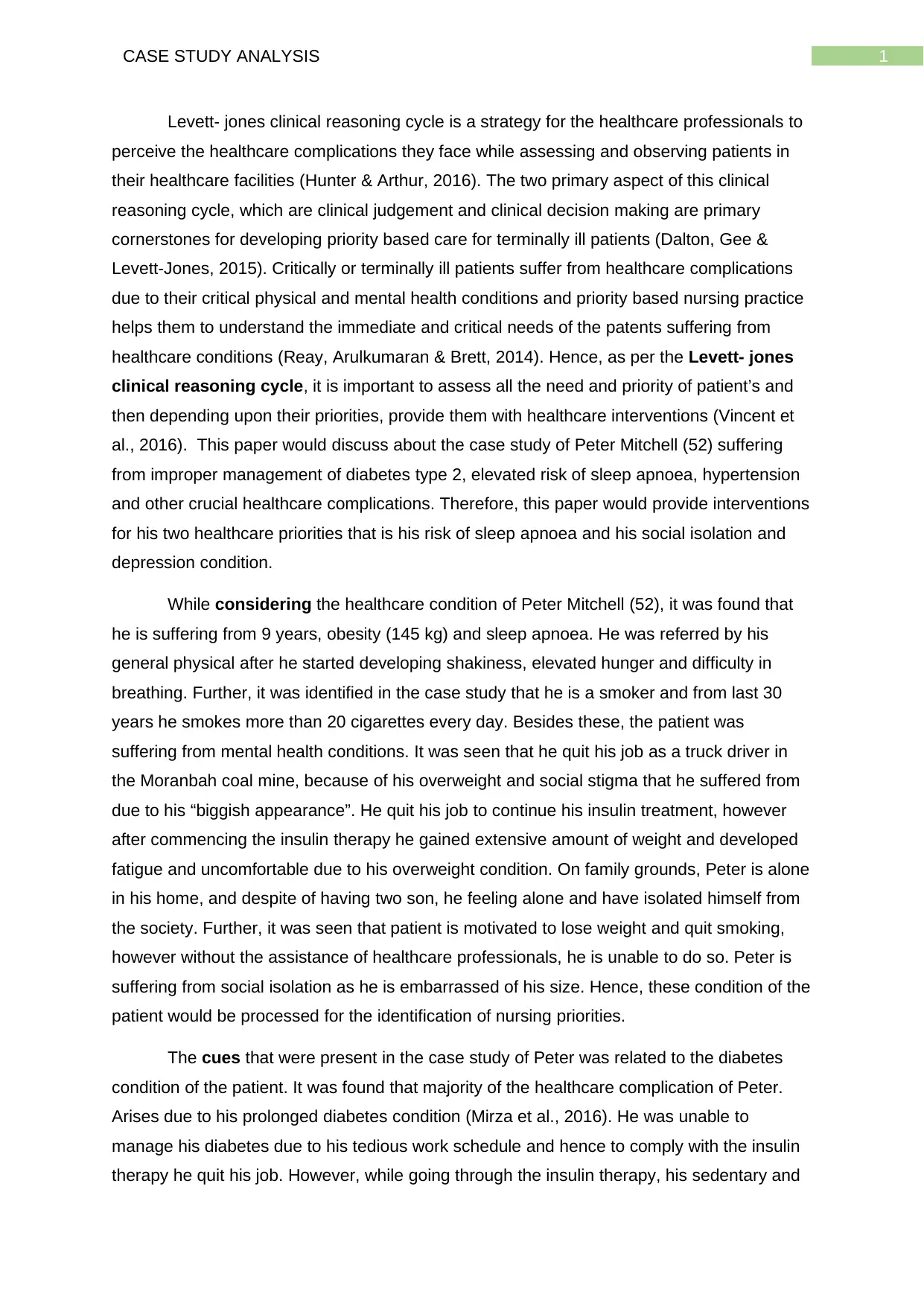
1CASE STUDY ANALYSIS
Levett- jones clinical reasoning cycle is a strategy for the healthcare professionals to
perceive the healthcare complications they face while assessing and observing patients in
their healthcare facilities (Hunter & Arthur, 2016). The two primary aspect of this clinical
reasoning cycle, which are clinical judgement and clinical decision making are primary
cornerstones for developing priority based care for terminally ill patients (Dalton, Gee &
Levett-Jones, 2015). Critically or terminally ill patients suffer from healthcare complications
due to their critical physical and mental health conditions and priority based nursing practice
helps them to understand the immediate and critical needs of the patents suffering from
healthcare conditions (Reay, Arulkumaran & Brett, 2014). Hence, as per the Levett- jones
clinical reasoning cycle, it is important to assess all the need and priority of patient’s and
then depending upon their priorities, provide them with healthcare interventions (Vincent et
al., 2016). This paper would discuss about the case study of Peter Mitchell (52) suffering
from improper management of diabetes type 2, elevated risk of sleep apnoea, hypertension
and other crucial healthcare complications. Therefore, this paper would provide interventions
for his two healthcare priorities that is his risk of sleep apnoea and his social isolation and
depression condition.
While considering the healthcare condition of Peter Mitchell (52), it was found that
he is suffering from 9 years, obesity (145 kg) and sleep apnoea. He was referred by his
general physical after he started developing shakiness, elevated hunger and difficulty in
breathing. Further, it was identified in the case study that he is a smoker and from last 30
years he smokes more than 20 cigarettes every day. Besides these, the patient was
suffering from mental health conditions. It was seen that he quit his job as a truck driver in
the Moranbah coal mine, because of his overweight and social stigma that he suffered from
due to his “biggish appearance”. He quit his job to continue his insulin treatment, however
after commencing the insulin therapy he gained extensive amount of weight and developed
fatigue and uncomfortable due to his overweight condition. On family grounds, Peter is alone
in his home, and despite of having two son, he feeling alone and have isolated himself from
the society. Further, it was seen that patient is motivated to lose weight and quit smoking,
however without the assistance of healthcare professionals, he is unable to do so. Peter is
suffering from social isolation as he is embarrassed of his size. Hence, these condition of the
patient would be processed for the identification of nursing priorities.
The cues that were present in the case study of Peter was related to the diabetes
condition of the patient. It was found that majority of the healthcare complication of Peter.
Arises due to his prolonged diabetes condition (Mirza et al., 2016). He was unable to
manage his diabetes due to his tedious work schedule and hence to comply with the insulin
therapy he quit his job. However, while going through the insulin therapy, his sedentary and
Levett- jones clinical reasoning cycle is a strategy for the healthcare professionals to
perceive the healthcare complications they face while assessing and observing patients in
their healthcare facilities (Hunter & Arthur, 2016). The two primary aspect of this clinical
reasoning cycle, which are clinical judgement and clinical decision making are primary
cornerstones for developing priority based care for terminally ill patients (Dalton, Gee &
Levett-Jones, 2015). Critically or terminally ill patients suffer from healthcare complications
due to their critical physical and mental health conditions and priority based nursing practice
helps them to understand the immediate and critical needs of the patents suffering from
healthcare conditions (Reay, Arulkumaran & Brett, 2014). Hence, as per the Levett- jones
clinical reasoning cycle, it is important to assess all the need and priority of patient’s and
then depending upon their priorities, provide them with healthcare interventions (Vincent et
al., 2016). This paper would discuss about the case study of Peter Mitchell (52) suffering
from improper management of diabetes type 2, elevated risk of sleep apnoea, hypertension
and other crucial healthcare complications. Therefore, this paper would provide interventions
for his two healthcare priorities that is his risk of sleep apnoea and his social isolation and
depression condition.
While considering the healthcare condition of Peter Mitchell (52), it was found that
he is suffering from 9 years, obesity (145 kg) and sleep apnoea. He was referred by his
general physical after he started developing shakiness, elevated hunger and difficulty in
breathing. Further, it was identified in the case study that he is a smoker and from last 30
years he smokes more than 20 cigarettes every day. Besides these, the patient was
suffering from mental health conditions. It was seen that he quit his job as a truck driver in
the Moranbah coal mine, because of his overweight and social stigma that he suffered from
due to his “biggish appearance”. He quit his job to continue his insulin treatment, however
after commencing the insulin therapy he gained extensive amount of weight and developed
fatigue and uncomfortable due to his overweight condition. On family grounds, Peter is alone
in his home, and despite of having two son, he feeling alone and have isolated himself from
the society. Further, it was seen that patient is motivated to lose weight and quit smoking,
however without the assistance of healthcare professionals, he is unable to do so. Peter is
suffering from social isolation as he is embarrassed of his size. Hence, these condition of the
patient would be processed for the identification of nursing priorities.
The cues that were present in the case study of Peter was related to the diabetes
condition of the patient. It was found that majority of the healthcare complication of Peter.
Arises due to his prolonged diabetes condition (Mirza et al., 2016). He was unable to
manage his diabetes due to his tedious work schedule and hence to comply with the insulin
therapy he quit his job. However, while going through the insulin therapy, his sedentary and

2CASE STUDY ANALYSIS
inactive lifestyle increased his overweight condition and he gained more than 40Kg of weight
(Chen et al., 2014). Further, it was seen that due to his overweight, he become conscious,
and societally stigmatized, that increased his mental health concerns, elevated his blood
pressure and ultimately lead to hypertension and depression. Further, his workplace, the
Moranbah coal mine could be a primary reason for his breathing concerns as Rafeemanesh
et al. (2014) mentions that workers of mines and similar work environment suffer from
severe airway disorders in their lifetime and hence it could another cue for his breathing
disorder. Besides this, due to overweight condition, he developed sleep apnoea and
developed risk factor for cardiovascular health conditions (Jordan, McSharry & Malhotra,
2014). While analysing his mental health condition, it was seen that the patient lives alone
and due to overweight health condition, prolonged suffering of diabetes he developed severe
depression and lost his self-confidence (Mirza et al., 2016). However, these was a positive
cue in his health condition as the patient was motivated to lose weight, hence this would be
utilised in the care process of the patient.
While processing the above- mentioned cues, it was seen that the one healthcare
condition of Peter, was the primary reason for another complication. As he lives alone, and
does not have sound knowledge of healthcare, process, due to which he was unable to
control or manage his elevated diabetes condition (Dawes et al., 2016). Further, his
workplace increased his healthcare risk by increasing the risk factor related to airway
disorders and it is observed in the case study that he is suffering from breathing disorders
(Rafeemanesh et al., 2014). Further, connection between his inactive lifestyle, and increased
obesity was also noticed as after quitting his job he was completely inactive and in the
course, his weight increased from 105 kg to 145 kg (Jordan, McSharry & Malhotra, 2014).
Further, due to his inactive lifestyle, prolonged disease condition and ignorance of his family,
he developed social stigma, mental health conditions, and lost his self-confidence, which
could have helped him to overcome his healthcare concerns (Assari, 2014). Therefore, due
to his diabetes concern, all other secondary healthcare conditions arises and he suffered
from both mental health and physical healthcare complications.
Therefore, the problems which were identified form the healthcare cues and
information of Peter’s case study was his prolonged diabetes condition that increased his
weight and developed sleep apnoea condition (American Diabetes Association, 2015).
Further, this was the primary reason for his overeating habit, shakiness and depression,
Therefore, his first priority of care would be sleep apnoea as it could develop severe
cardiac disorder (Floras et al., 2014). This would be achieved by providing him weight loss
and healthcare literacy. Further, it was seen that providing healthcare literacy is effective in
majority of the patients suffering from depression so it could make them aware of their illness
inactive lifestyle increased his overweight condition and he gained more than 40Kg of weight
(Chen et al., 2014). Further, it was seen that due to his overweight, he become conscious,
and societally stigmatized, that increased his mental health concerns, elevated his blood
pressure and ultimately lead to hypertension and depression. Further, his workplace, the
Moranbah coal mine could be a primary reason for his breathing concerns as Rafeemanesh
et al. (2014) mentions that workers of mines and similar work environment suffer from
severe airway disorders in their lifetime and hence it could another cue for his breathing
disorder. Besides this, due to overweight condition, he developed sleep apnoea and
developed risk factor for cardiovascular health conditions (Jordan, McSharry & Malhotra,
2014). While analysing his mental health condition, it was seen that the patient lives alone
and due to overweight health condition, prolonged suffering of diabetes he developed severe
depression and lost his self-confidence (Mirza et al., 2016). However, these was a positive
cue in his health condition as the patient was motivated to lose weight, hence this would be
utilised in the care process of the patient.
While processing the above- mentioned cues, it was seen that the one healthcare
condition of Peter, was the primary reason for another complication. As he lives alone, and
does not have sound knowledge of healthcare, process, due to which he was unable to
control or manage his elevated diabetes condition (Dawes et al., 2016). Further, his
workplace increased his healthcare risk by increasing the risk factor related to airway
disorders and it is observed in the case study that he is suffering from breathing disorders
(Rafeemanesh et al., 2014). Further, connection between his inactive lifestyle, and increased
obesity was also noticed as after quitting his job he was completely inactive and in the
course, his weight increased from 105 kg to 145 kg (Jordan, McSharry & Malhotra, 2014).
Further, due to his inactive lifestyle, prolonged disease condition and ignorance of his family,
he developed social stigma, mental health conditions, and lost his self-confidence, which
could have helped him to overcome his healthcare concerns (Assari, 2014). Therefore, due
to his diabetes concern, all other secondary healthcare conditions arises and he suffered
from both mental health and physical healthcare complications.
Therefore, the problems which were identified form the healthcare cues and
information of Peter’s case study was his prolonged diabetes condition that increased his
weight and developed sleep apnoea condition (American Diabetes Association, 2015).
Further, this was the primary reason for his overeating habit, shakiness and depression,
Therefore, his first priority of care would be sleep apnoea as it could develop severe
cardiac disorder (Floras et al., 2014). This would be achieved by providing him weight loss
and healthcare literacy. Further, it was seen that providing healthcare literacy is effective in
majority of the patients suffering from depression so it could make them aware of their illness
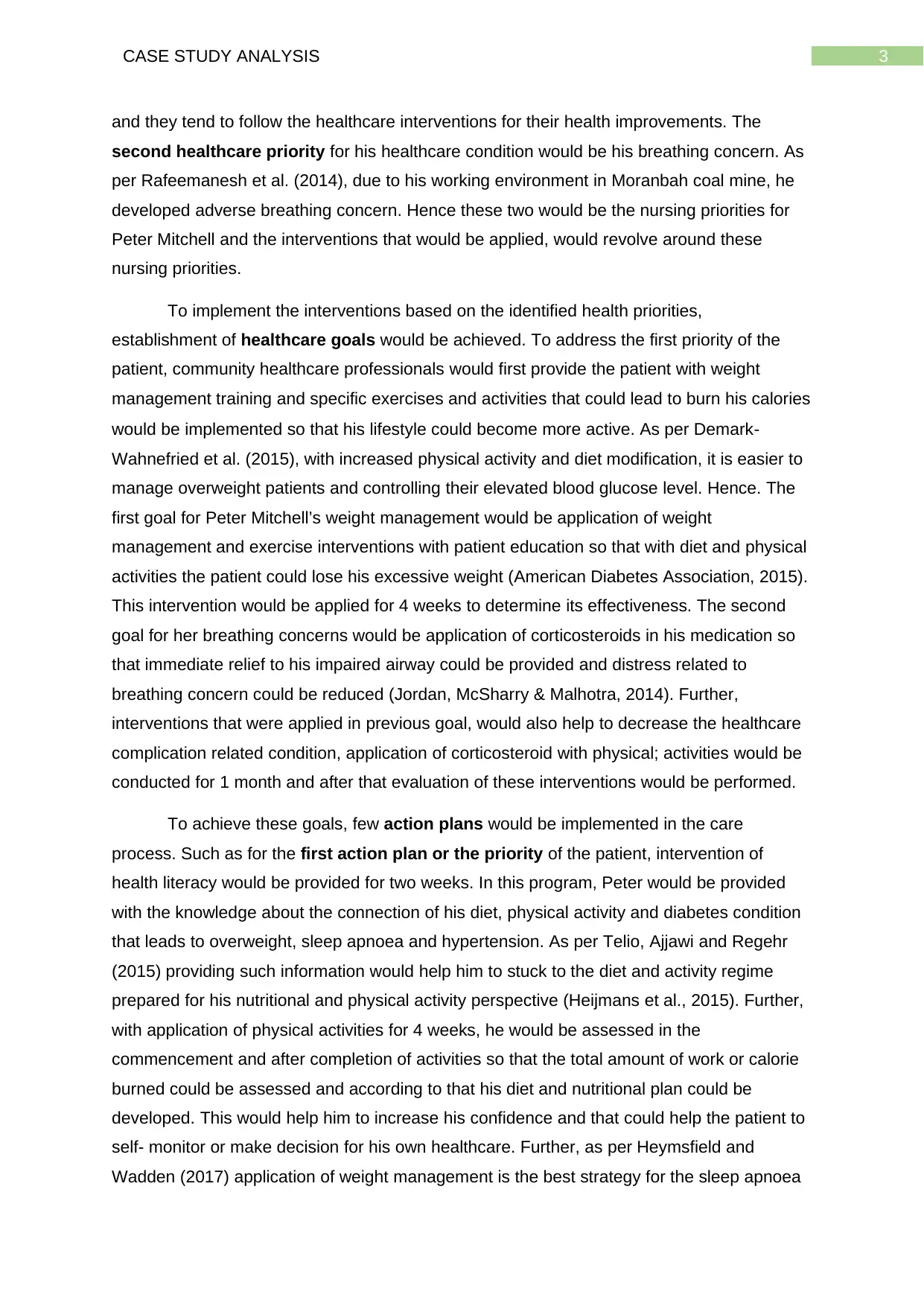
3CASE STUDY ANALYSIS
and they tend to follow the healthcare interventions for their health improvements. The
second healthcare priority for his healthcare condition would be his breathing concern. As
per Rafeemanesh et al. (2014), due to his working environment in Moranbah coal mine, he
developed adverse breathing concern. Hence these two would be the nursing priorities for
Peter Mitchell and the interventions that would be applied, would revolve around these
nursing priorities.
To implement the interventions based on the identified health priorities,
establishment of healthcare goals would be achieved. To address the first priority of the
patient, community healthcare professionals would first provide the patient with weight
management training and specific exercises and activities that could lead to burn his calories
would be implemented so that his lifestyle could become more active. As per Demark‐
Wahnefried et al. (2015), with increased physical activity and diet modification, it is easier to
manage overweight patients and controlling their elevated blood glucose level. Hence. The
first goal for Peter Mitchell’s weight management would be application of weight
management and exercise interventions with patient education so that with diet and physical
activities the patient could lose his excessive weight (American Diabetes Association, 2015).
This intervention would be applied for 4 weeks to determine its effectiveness. The second
goal for her breathing concerns would be application of corticosteroids in his medication so
that immediate relief to his impaired airway could be provided and distress related to
breathing concern could be reduced (Jordan, McSharry & Malhotra, 2014). Further,
interventions that were applied in previous goal, would also help to decrease the healthcare
complication related condition, application of corticosteroid with physical; activities would be
conducted for 1 month and after that evaluation of these interventions would be performed.
To achieve these goals, few action plans would be implemented in the care
process. Such as for the first action plan or the priority of the patient, intervention of
health literacy would be provided for two weeks. In this program, Peter would be provided
with the knowledge about the connection of his diet, physical activity and diabetes condition
that leads to overweight, sleep apnoea and hypertension. As per Telio, Ajjawi and Regehr
(2015) providing such information would help him to stuck to the diet and activity regime
prepared for his nutritional and physical activity perspective (Heijmans et al., 2015). Further,
with application of physical activities for 4 weeks, he would be assessed in the
commencement and after completion of activities so that the total amount of work or calorie
burned could be assessed and according to that his diet and nutritional plan could be
developed. This would help him to increase his confidence and that could help the patient to
self- monitor or make decision for his own healthcare. Further, as per Heymsfield and
Wadden (2017) application of weight management is the best strategy for the sleep apnoea
and they tend to follow the healthcare interventions for their health improvements. The
second healthcare priority for his healthcare condition would be his breathing concern. As
per Rafeemanesh et al. (2014), due to his working environment in Moranbah coal mine, he
developed adverse breathing concern. Hence these two would be the nursing priorities for
Peter Mitchell and the interventions that would be applied, would revolve around these
nursing priorities.
To implement the interventions based on the identified health priorities,
establishment of healthcare goals would be achieved. To address the first priority of the
patient, community healthcare professionals would first provide the patient with weight
management training and specific exercises and activities that could lead to burn his calories
would be implemented so that his lifestyle could become more active. As per Demark‐
Wahnefried et al. (2015), with increased physical activity and diet modification, it is easier to
manage overweight patients and controlling their elevated blood glucose level. Hence. The
first goal for Peter Mitchell’s weight management would be application of weight
management and exercise interventions with patient education so that with diet and physical
activities the patient could lose his excessive weight (American Diabetes Association, 2015).
This intervention would be applied for 4 weeks to determine its effectiveness. The second
goal for her breathing concerns would be application of corticosteroids in his medication so
that immediate relief to his impaired airway could be provided and distress related to
breathing concern could be reduced (Jordan, McSharry & Malhotra, 2014). Further,
interventions that were applied in previous goal, would also help to decrease the healthcare
complication related condition, application of corticosteroid with physical; activities would be
conducted for 1 month and after that evaluation of these interventions would be performed.
To achieve these goals, few action plans would be implemented in the care
process. Such as for the first action plan or the priority of the patient, intervention of
health literacy would be provided for two weeks. In this program, Peter would be provided
with the knowledge about the connection of his diet, physical activity and diabetes condition
that leads to overweight, sleep apnoea and hypertension. As per Telio, Ajjawi and Regehr
(2015) providing such information would help him to stuck to the diet and activity regime
prepared for his nutritional and physical activity perspective (Heijmans et al., 2015). Further,
with application of physical activities for 4 weeks, he would be assessed in the
commencement and after completion of activities so that the total amount of work or calorie
burned could be assessed and according to that his diet and nutritional plan could be
developed. This would help him to increase his confidence and that could help the patient to
self- monitor or make decision for his own healthcare. Further, as per Heymsfield and
Wadden (2017) application of weight management is the best strategy for the sleep apnoea
Secure Best Marks with AI Grader
Need help grading? Try our AI Grader for instant feedback on your assignments.
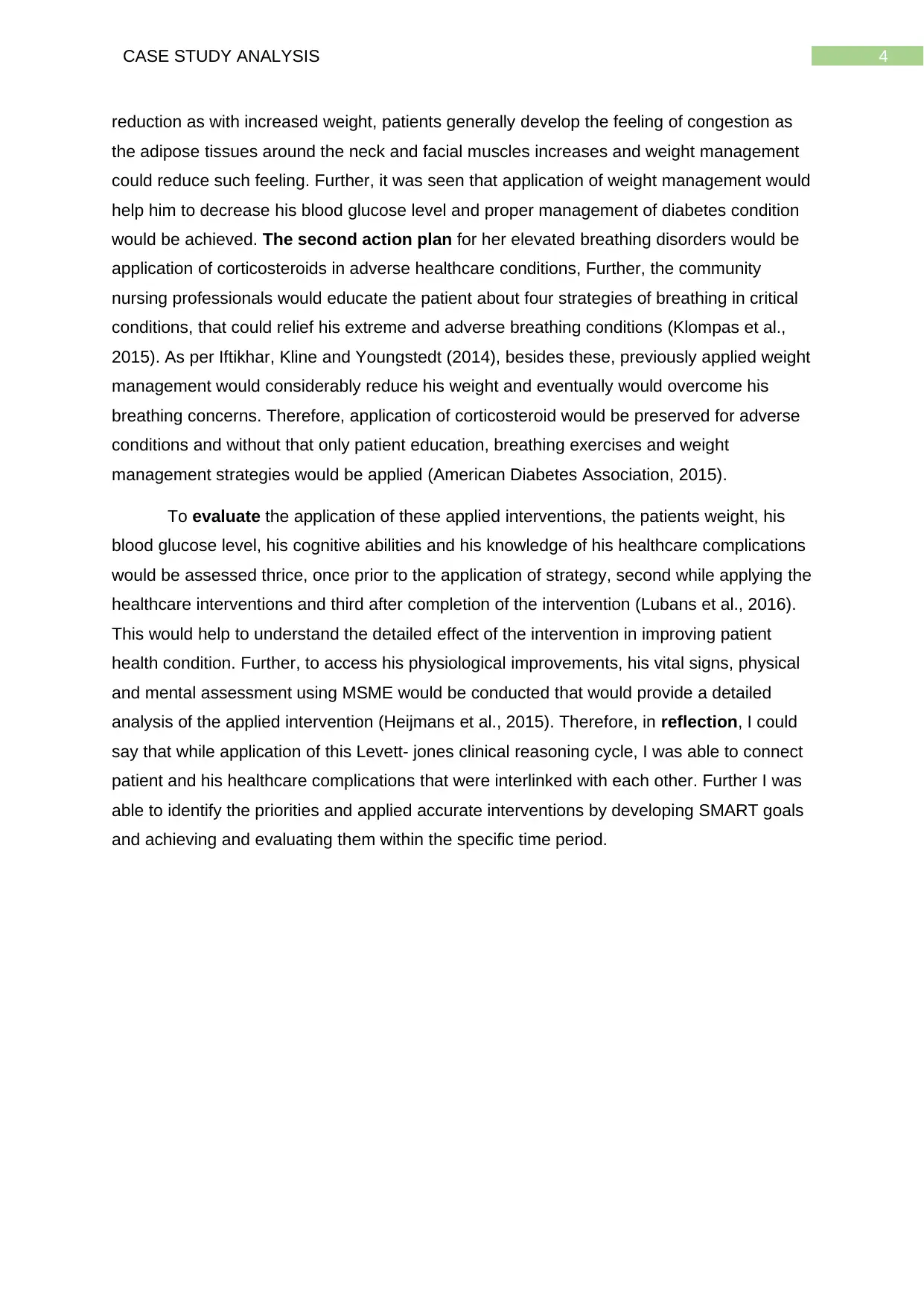
4CASE STUDY ANALYSIS
reduction as with increased weight, patients generally develop the feeling of congestion as
the adipose tissues around the neck and facial muscles increases and weight management
could reduce such feeling. Further, it was seen that application of weight management would
help him to decrease his blood glucose level and proper management of diabetes condition
would be achieved. The second action plan for her elevated breathing disorders would be
application of corticosteroids in adverse healthcare conditions, Further, the community
nursing professionals would educate the patient about four strategies of breathing in critical
conditions, that could relief his extreme and adverse breathing conditions (Klompas et al.,
2015). As per Iftikhar, Kline and Youngstedt (2014), besides these, previously applied weight
management would considerably reduce his weight and eventually would overcome his
breathing concerns. Therefore, application of corticosteroid would be preserved for adverse
conditions and without that only patient education, breathing exercises and weight
management strategies would be applied (American Diabetes Association, 2015).
To evaluate the application of these applied interventions, the patients weight, his
blood glucose level, his cognitive abilities and his knowledge of his healthcare complications
would be assessed thrice, once prior to the application of strategy, second while applying the
healthcare interventions and third after completion of the intervention (Lubans et al., 2016).
This would help to understand the detailed effect of the intervention in improving patient
health condition. Further, to access his physiological improvements, his vital signs, physical
and mental assessment using MSME would be conducted that would provide a detailed
analysis of the applied intervention (Heijmans et al., 2015). Therefore, in reflection, I could
say that while application of this Levett- jones clinical reasoning cycle, I was able to connect
patient and his healthcare complications that were interlinked with each other. Further I was
able to identify the priorities and applied accurate interventions by developing SMART goals
and achieving and evaluating them within the specific time period.
reduction as with increased weight, patients generally develop the feeling of congestion as
the adipose tissues around the neck and facial muscles increases and weight management
could reduce such feeling. Further, it was seen that application of weight management would
help him to decrease his blood glucose level and proper management of diabetes condition
would be achieved. The second action plan for her elevated breathing disorders would be
application of corticosteroids in adverse healthcare conditions, Further, the community
nursing professionals would educate the patient about four strategies of breathing in critical
conditions, that could relief his extreme and adverse breathing conditions (Klompas et al.,
2015). As per Iftikhar, Kline and Youngstedt (2014), besides these, previously applied weight
management would considerably reduce his weight and eventually would overcome his
breathing concerns. Therefore, application of corticosteroid would be preserved for adverse
conditions and without that only patient education, breathing exercises and weight
management strategies would be applied (American Diabetes Association, 2015).
To evaluate the application of these applied interventions, the patients weight, his
blood glucose level, his cognitive abilities and his knowledge of his healthcare complications
would be assessed thrice, once prior to the application of strategy, second while applying the
healthcare interventions and third after completion of the intervention (Lubans et al., 2016).
This would help to understand the detailed effect of the intervention in improving patient
health condition. Further, to access his physiological improvements, his vital signs, physical
and mental assessment using MSME would be conducted that would provide a detailed
analysis of the applied intervention (Heijmans et al., 2015). Therefore, in reflection, I could
say that while application of this Levett- jones clinical reasoning cycle, I was able to connect
patient and his healthcare complications that were interlinked with each other. Further I was
able to identify the priorities and applied accurate interventions by developing SMART goals
and achieving and evaluating them within the specific time period.
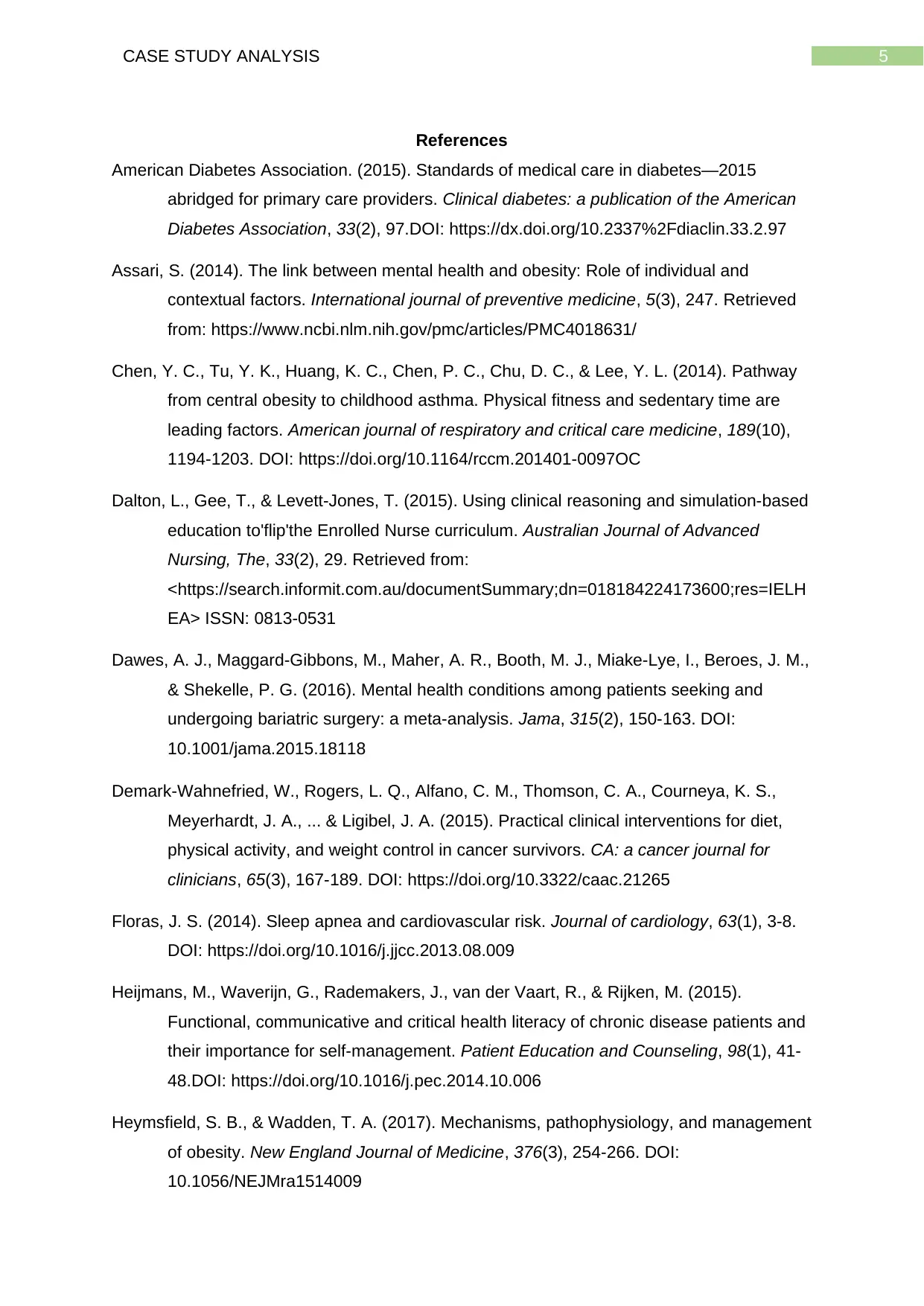
5CASE STUDY ANALYSIS
References
American Diabetes Association. (2015). Standards of medical care in diabetes—2015
abridged for primary care providers. Clinical diabetes: a publication of the American
Diabetes Association, 33(2), 97.DOI: https://dx.doi.org/10.2337%2Fdiaclin.33.2.97
Assari, S. (2014). The link between mental health and obesity: Role of individual and
contextual factors. International journal of preventive medicine, 5(3), 247. Retrieved
from: https://www.ncbi.nlm.nih.gov/pmc/articles/PMC4018631/
Chen, Y. C., Tu, Y. K., Huang, K. C., Chen, P. C., Chu, D. C., & Lee, Y. L. (2014). Pathway
from central obesity to childhood asthma. Physical fitness and sedentary time are
leading factors. American journal of respiratory and critical care medicine, 189(10),
1194-1203. DOI: https://doi.org/10.1164/rccm.201401-0097OC
Dalton, L., Gee, T., & Levett-Jones, T. (2015). Using clinical reasoning and simulation-based
education to'flip'the Enrolled Nurse curriculum. Australian Journal of Advanced
Nursing, The, 33(2), 29. Retrieved from:
<https://search.informit.com.au/documentSummary;dn=018184224173600;res=IELH
EA> ISSN: 0813-0531
Dawes, A. J., Maggard-Gibbons, M., Maher, A. R., Booth, M. J., Miake-Lye, I., Beroes, J. M.,
& Shekelle, P. G. (2016). Mental health conditions among patients seeking and
undergoing bariatric surgery: a meta-analysis. Jama, 315(2), 150-163. DOI:
10.1001/jama.2015.18118
Demark‐Wahnefried, W., Rogers, L. Q., Alfano, C. M., Thomson, C. A., Courneya, K. S.,
Meyerhardt, J. A., ... & Ligibel, J. A. (2015). Practical clinical interventions for diet,
physical activity, and weight control in cancer survivors. CA: a cancer journal for
clinicians, 65(3), 167-189. DOI: https://doi.org/10.3322/caac.21265
Floras, J. S. (2014). Sleep apnea and cardiovascular risk. Journal of cardiology, 63(1), 3-8.
DOI: https://doi.org/10.1016/j.jjcc.2013.08.009
Heijmans, M., Waverijn, G., Rademakers, J., van der Vaart, R., & Rijken, M. (2015).
Functional, communicative and critical health literacy of chronic disease patients and
their importance for self-management. Patient Education and Counseling, 98(1), 41-
48.DOI: https://doi.org/10.1016/j.pec.2014.10.006
Heymsfield, S. B., & Wadden, T. A. (2017). Mechanisms, pathophysiology, and management
of obesity. New England Journal of Medicine, 376(3), 254-266. DOI:
10.1056/NEJMra1514009
References
American Diabetes Association. (2015). Standards of medical care in diabetes—2015
abridged for primary care providers. Clinical diabetes: a publication of the American
Diabetes Association, 33(2), 97.DOI: https://dx.doi.org/10.2337%2Fdiaclin.33.2.97
Assari, S. (2014). The link between mental health and obesity: Role of individual and
contextual factors. International journal of preventive medicine, 5(3), 247. Retrieved
from: https://www.ncbi.nlm.nih.gov/pmc/articles/PMC4018631/
Chen, Y. C., Tu, Y. K., Huang, K. C., Chen, P. C., Chu, D. C., & Lee, Y. L. (2014). Pathway
from central obesity to childhood asthma. Physical fitness and sedentary time are
leading factors. American journal of respiratory and critical care medicine, 189(10),
1194-1203. DOI: https://doi.org/10.1164/rccm.201401-0097OC
Dalton, L., Gee, T., & Levett-Jones, T. (2015). Using clinical reasoning and simulation-based
education to'flip'the Enrolled Nurse curriculum. Australian Journal of Advanced
Nursing, The, 33(2), 29. Retrieved from:
<https://search.informit.com.au/documentSummary;dn=018184224173600;res=IELH
EA> ISSN: 0813-0531
Dawes, A. J., Maggard-Gibbons, M., Maher, A. R., Booth, M. J., Miake-Lye, I., Beroes, J. M.,
& Shekelle, P. G. (2016). Mental health conditions among patients seeking and
undergoing bariatric surgery: a meta-analysis. Jama, 315(2), 150-163. DOI:
10.1001/jama.2015.18118
Demark‐Wahnefried, W., Rogers, L. Q., Alfano, C. M., Thomson, C. A., Courneya, K. S.,
Meyerhardt, J. A., ... & Ligibel, J. A. (2015). Practical clinical interventions for diet,
physical activity, and weight control in cancer survivors. CA: a cancer journal for
clinicians, 65(3), 167-189. DOI: https://doi.org/10.3322/caac.21265
Floras, J. S. (2014). Sleep apnea and cardiovascular risk. Journal of cardiology, 63(1), 3-8.
DOI: https://doi.org/10.1016/j.jjcc.2013.08.009
Heijmans, M., Waverijn, G., Rademakers, J., van der Vaart, R., & Rijken, M. (2015).
Functional, communicative and critical health literacy of chronic disease patients and
their importance for self-management. Patient Education and Counseling, 98(1), 41-
48.DOI: https://doi.org/10.1016/j.pec.2014.10.006
Heymsfield, S. B., & Wadden, T. A. (2017). Mechanisms, pathophysiology, and management
of obesity. New England Journal of Medicine, 376(3), 254-266. DOI:
10.1056/NEJMra1514009
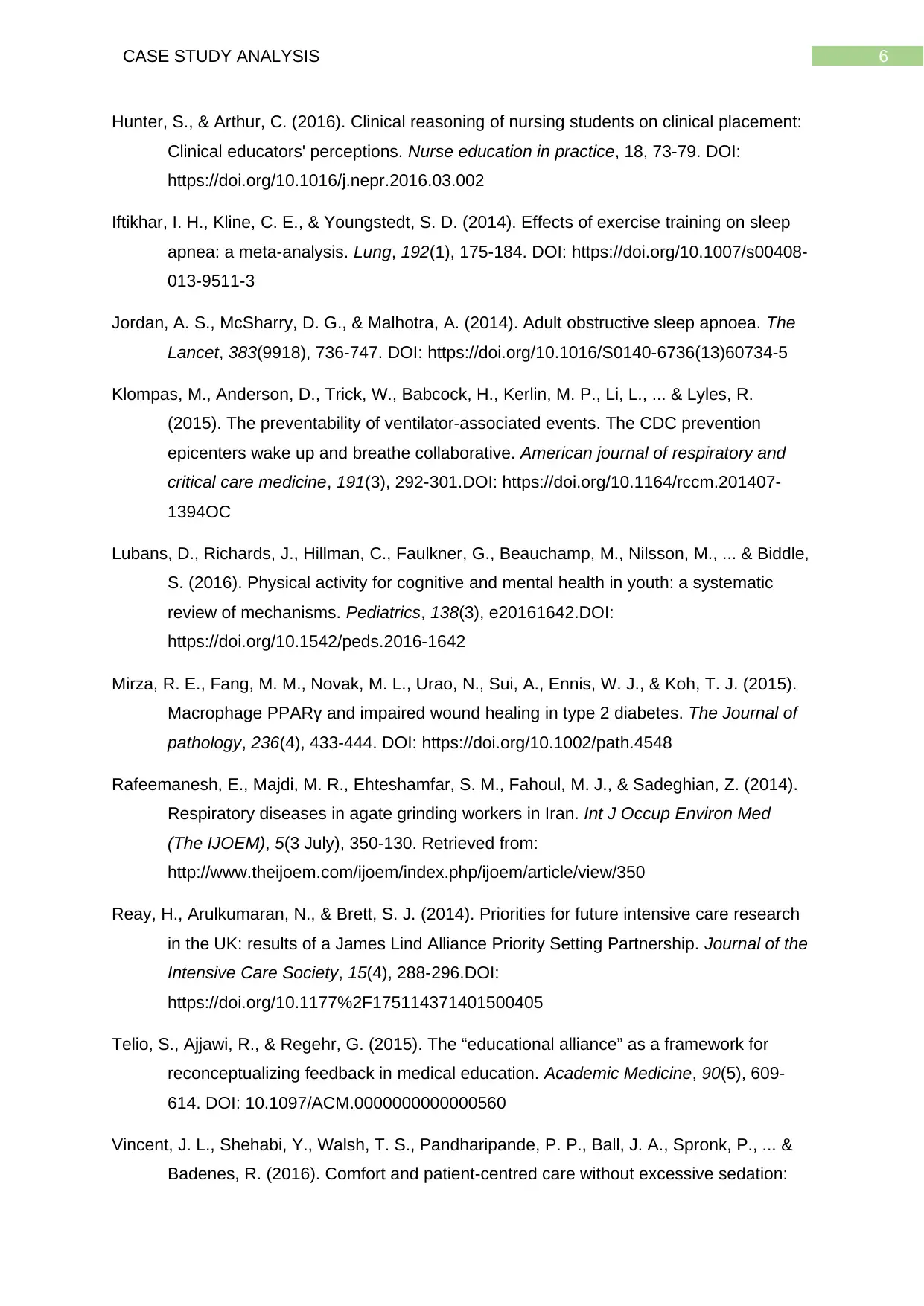
6CASE STUDY ANALYSIS
Hunter, S., & Arthur, C. (2016). Clinical reasoning of nursing students on clinical placement:
Clinical educators' perceptions. Nurse education in practice, 18, 73-79. DOI:
https://doi.org/10.1016/j.nepr.2016.03.002
Iftikhar, I. H., Kline, C. E., & Youngstedt, S. D. (2014). Effects of exercise training on sleep
apnea: a meta-analysis. Lung, 192(1), 175-184. DOI: https://doi.org/10.1007/s00408-
013-9511-3
Jordan, A. S., McSharry, D. G., & Malhotra, A. (2014). Adult obstructive sleep apnoea. The
Lancet, 383(9918), 736-747. DOI: https://doi.org/10.1016/S0140-6736(13)60734-5
Klompas, M., Anderson, D., Trick, W., Babcock, H., Kerlin, M. P., Li, L., ... & Lyles, R.
(2015). The preventability of ventilator-associated events. The CDC prevention
epicenters wake up and breathe collaborative. American journal of respiratory and
critical care medicine, 191(3), 292-301.DOI: https://doi.org/10.1164/rccm.201407-
1394OC
Lubans, D., Richards, J., Hillman, C., Faulkner, G., Beauchamp, M., Nilsson, M., ... & Biddle,
S. (2016). Physical activity for cognitive and mental health in youth: a systematic
review of mechanisms. Pediatrics, 138(3), e20161642.DOI:
https://doi.org/10.1542/peds.2016-1642
Mirza, R. E., Fang, M. M., Novak, M. L., Urao, N., Sui, A., Ennis, W. J., & Koh, T. J. (2015).
Macrophage PPARγ and impaired wound healing in type 2 diabetes. The Journal of
pathology, 236(4), 433-444. DOI: https://doi.org/10.1002/path.4548
Rafeemanesh, E., Majdi, M. R., Ehteshamfar, S. M., Fahoul, M. J., & Sadeghian, Z. (2014).
Respiratory diseases in agate grinding workers in Iran. Int J Occup Environ Med
(The IJOEM), 5(3 July), 350-130. Retrieved from:
http://www.theijoem.com/ijoem/index.php/ijoem/article/view/350
Reay, H., Arulkumaran, N., & Brett, S. J. (2014). Priorities for future intensive care research
in the UK: results of a James Lind Alliance Priority Setting Partnership. Journal of the
Intensive Care Society, 15(4), 288-296.DOI:
https://doi.org/10.1177%2F175114371401500405
Telio, S., Ajjawi, R., & Regehr, G. (2015). The “educational alliance” as a framework for
reconceptualizing feedback in medical education. Academic Medicine, 90(5), 609-
614. DOI: 10.1097/ACM.0000000000000560
Vincent, J. L., Shehabi, Y., Walsh, T. S., Pandharipande, P. P., Ball, J. A., Spronk, P., ... &
Badenes, R. (2016). Comfort and patient-centred care without excessive sedation:
Hunter, S., & Arthur, C. (2016). Clinical reasoning of nursing students on clinical placement:
Clinical educators' perceptions. Nurse education in practice, 18, 73-79. DOI:
https://doi.org/10.1016/j.nepr.2016.03.002
Iftikhar, I. H., Kline, C. E., & Youngstedt, S. D. (2014). Effects of exercise training on sleep
apnea: a meta-analysis. Lung, 192(1), 175-184. DOI: https://doi.org/10.1007/s00408-
013-9511-3
Jordan, A. S., McSharry, D. G., & Malhotra, A. (2014). Adult obstructive sleep apnoea. The
Lancet, 383(9918), 736-747. DOI: https://doi.org/10.1016/S0140-6736(13)60734-5
Klompas, M., Anderson, D., Trick, W., Babcock, H., Kerlin, M. P., Li, L., ... & Lyles, R.
(2015). The preventability of ventilator-associated events. The CDC prevention
epicenters wake up and breathe collaborative. American journal of respiratory and
critical care medicine, 191(3), 292-301.DOI: https://doi.org/10.1164/rccm.201407-
1394OC
Lubans, D., Richards, J., Hillman, C., Faulkner, G., Beauchamp, M., Nilsson, M., ... & Biddle,
S. (2016). Physical activity for cognitive and mental health in youth: a systematic
review of mechanisms. Pediatrics, 138(3), e20161642.DOI:
https://doi.org/10.1542/peds.2016-1642
Mirza, R. E., Fang, M. M., Novak, M. L., Urao, N., Sui, A., Ennis, W. J., & Koh, T. J. (2015).
Macrophage PPARγ and impaired wound healing in type 2 diabetes. The Journal of
pathology, 236(4), 433-444. DOI: https://doi.org/10.1002/path.4548
Rafeemanesh, E., Majdi, M. R., Ehteshamfar, S. M., Fahoul, M. J., & Sadeghian, Z. (2014).
Respiratory diseases in agate grinding workers in Iran. Int J Occup Environ Med
(The IJOEM), 5(3 July), 350-130. Retrieved from:
http://www.theijoem.com/ijoem/index.php/ijoem/article/view/350
Reay, H., Arulkumaran, N., & Brett, S. J. (2014). Priorities for future intensive care research
in the UK: results of a James Lind Alliance Priority Setting Partnership. Journal of the
Intensive Care Society, 15(4), 288-296.DOI:
https://doi.org/10.1177%2F175114371401500405
Telio, S., Ajjawi, R., & Regehr, G. (2015). The “educational alliance” as a framework for
reconceptualizing feedback in medical education. Academic Medicine, 90(5), 609-
614. DOI: 10.1097/ACM.0000000000000560
Vincent, J. L., Shehabi, Y., Walsh, T. S., Pandharipande, P. P., Ball, J. A., Spronk, P., ... &
Badenes, R. (2016). Comfort and patient-centred care without excessive sedation:
Paraphrase This Document
Need a fresh take? Get an instant paraphrase of this document with our AI Paraphraser

7CASE STUDY ANALYSIS
the eCASH concept. Intensive care medicine, 42(6), 962-971. DOI:
https://doi.org/10.1007/s00134-016-4297-4
the eCASH concept. Intensive care medicine, 42(6), 962-971. DOI:
https://doi.org/10.1007/s00134-016-4297-4
1 out of 8
Related Documents
Your All-in-One AI-Powered Toolkit for Academic Success.
+13062052269
info@desklib.com
Available 24*7 on WhatsApp / Email
![[object Object]](/_next/static/media/star-bottom.7253800d.svg)
Unlock your academic potential
© 2024 | Zucol Services PVT LTD | All rights reserved.





